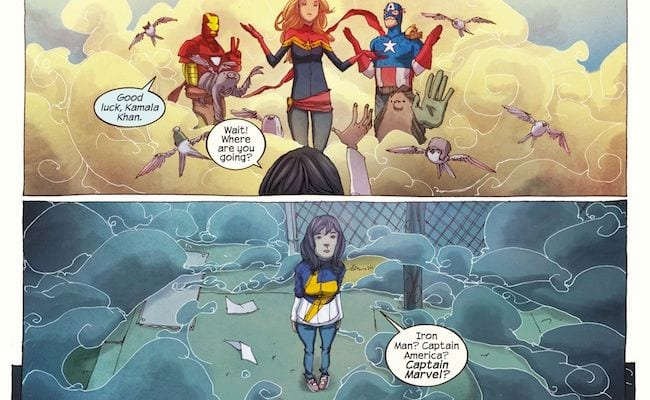
Look at most superhero comics and you’ll see a white, probably male, face staring back at you. Considering that most of the greats were created between 1938 and 1963, this shouldn’t be surprising. Yet, while the culture has moved forward, most comic characters’ racial and sexual identity remains fixed in the past.
With writer G. Willow Wilson and artists Adrian Alphona and Ian Herring’s Ms. Marvel #1, mainstream superhero comics are injected with a dose of authentic multiculturalism. Of course, superheroes have held these sensibilities for decades. Just look at Superman, the originator of the genre. His is the story of an immigrant learning to fit in with us Earthlings.
Nevertheless, overt and explicit handling of issues of race, ethnicity, and religion are rare. Even rarer is this being done well. And, certainly, Ms. Marvel is one of those rare comics. The set-up is intriguing and, while very little actually happens in this comic, what occurs convincingly builds the character, Kamala Khan, and the milieu she comes from.
Wilson avoids the obvious tokenism that could have dogged this project. From the get-go, there was an aura that this was being done less as a story that wanted to be told and more as a way for Marvel to grab headlines in USA Today. But Kamala has the trappings of a fully-fledged character, with a writer and art team that has a vision that they need to put on paper.
More importantly, Kamala Khan is a true-blue Marvel character, pioneered by the likes of Peter Parker. She even has the alliteration. She is constantly stuck between the constricting home life of her Pakistani parents and the bewildering mélange of teenage Americana. She emotes. People don’t understand her and she doesn’t even understand herself. It’s a potent mixture and one that makes her thoroughly belong to the world of Marvel.
When she receives her powers, she is struck by a vision of her three favorite superheroes: Iron Man, Captain American, and, Kamala’s hero, Carol Danvers in her Captain Marvel upgrade. Her dialogue, by Wilson, is just so sharp and relatable here:
“I grew up here! I’m from Jersey City, not Karachi!
“I don’t know what I’m supposed to do. I don’t know who I’m supposed to be.”
When asked by the Captain Marvel hallucination, “Who do you want to be,” Kamala answers:
“Right now? I want to be beautiful and awesome and butt-kicking and less complicated.
“I want to be you.
“Except I would wear the classic, politically incorrect costume and kick butt giant with wedge heels.”

Wilson’s writing really gets at the essence of what makes a Marvel character. This helps Kamala belong. It prevents her from being some tacked on addition, where all the seams show. With superheroes having such an entrenched fan base, new characters enter the arena of public opinion with two arms and a leg tied behind their backs. Sticking that landing that first issue is essential.
The art especially compliments this. Alphona and Herring create a storybook atmosphere through the light line work and muted, painterly colors, totally appropriate for the story of a striving outsider. Kamala’s parents are the typical immigrant couple, looking for their little slice of life in America. The grand immigrant narrative of the U.S. is our one shared storybook. It’s what lured all of our ancestor here and continues to do so this day.
Ms. Marvel #1 is a grand success. In other hands, this might have been a complete fiasco. Going at it too heavily could have been parochial and ran the risk of lecturing the reader. Taking a lighter approach could have made a tasteless, bland product, differentiated only in the skin wrapping the character.
Wilson, Alphona, and Herring have their full focus on creating a breathing character first, letting the story grow from that, and giving the reader a new, exciting perspective from which to play in the wide open Marvel sandbox.
